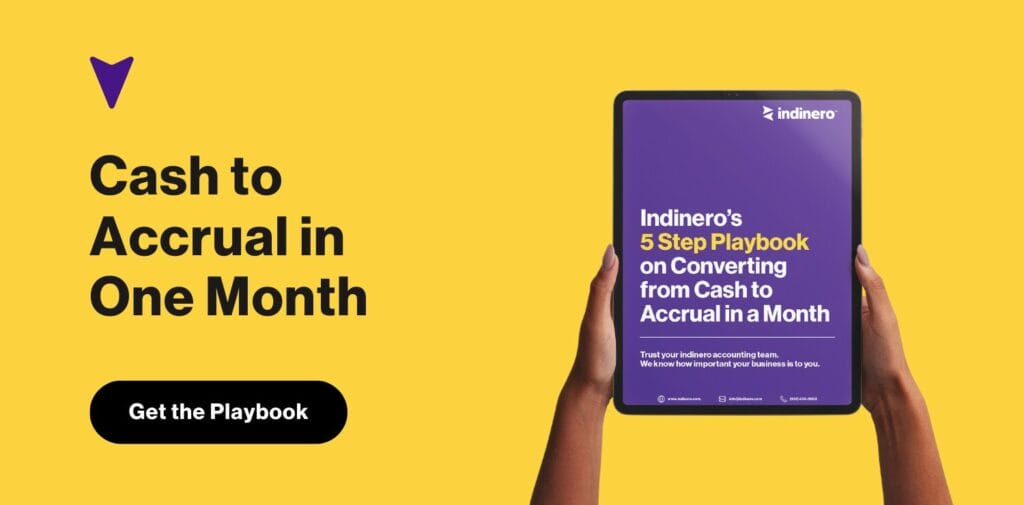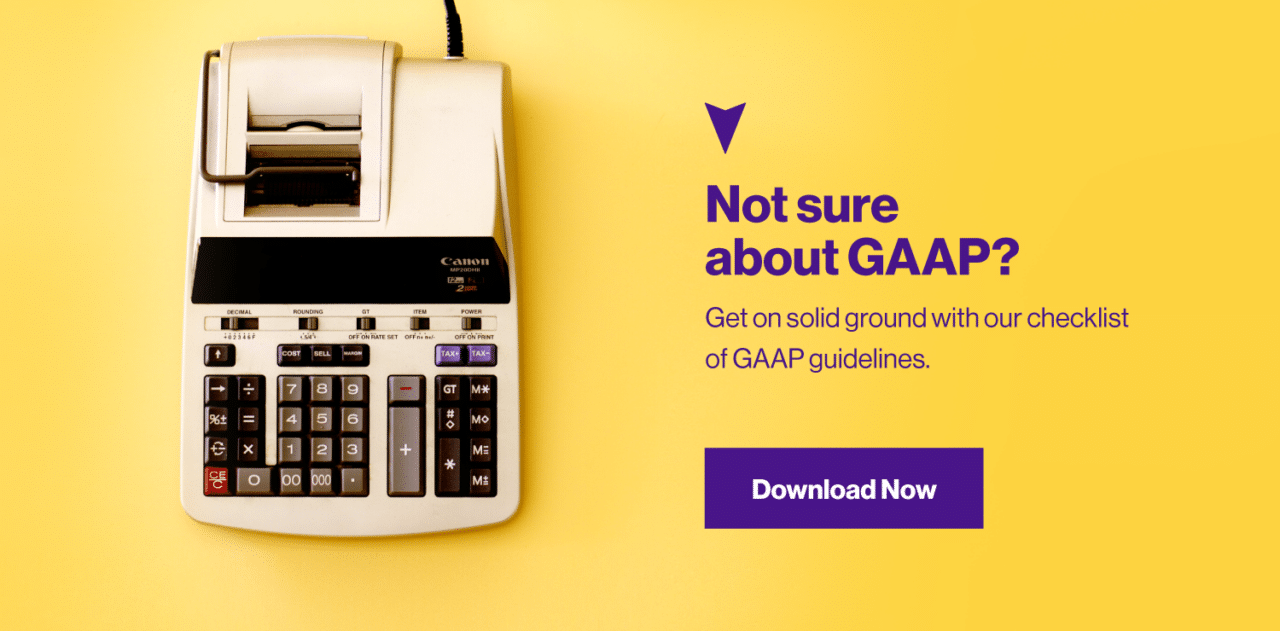Accrual Accounting is a vital component of Generally Accepted Accounting Principles (GAAP). It is like a complex machine, with many parts that must work together to create an effective system.
Understanding what is GAAP accounting can be challenging and daunting; however, with the right guidance, it can be achieved. This comprehensive guide provides an overview of GAAP accrual accounting, highlighting its basic principles, methods for recording transactions, cash versus accrual accounting methods, and more.
It also explains why only some businesses use GAAP and when it may be time to switch over. With this knowledge, you will gain insight into this important topic and have the tools needed to make informed decisions about their business practices.
What are Generally Accepted Accounting Principles (GAAP)?
Generally Accepted Accounting Principles (GAAP) are a set of accounting principles, standards, and procedures that define accepted accounting practice at a particular time. Its purpose is to ensure that financial statements provide an accurate and transparent view of the company’s financial condition and operations.
GAAP consists of specific components, including the history of GAAP, its objectives, principles, and standards, and its application in recording transactions.
A comprehensive understanding of these components will be discussed throughout this guide, including the history of GAAP, the purposes and objectives of GAAP, and the components of GAAP.
The History of GAAP
Tongue-in-cheek, one might say that General Accepted Accounting Principles (GAAP) have been around since the dawn of time; however, the reality is far more complex.
The history of GAAP dates back to 1929 when the Committee on Accounting Procedure was founded by the American Institute of Accountants and tasked with developing uniform accounting standards. Since then, GAAP has evolved in response to changing business practices, new technologies, and a need for consistent financial reporting.
Key milestones in its development include:
- The Securities Exchange Act of 1934 required companies listed on public exchanges to follow GAAP standards;
- The establishment of the Financial Accounting Standards Board (FASB) in 1973 as an independent body responsible for setting GAAP standards;
- Introduction of International Financial Reporting Standards (IFRS) in 2001; and
- Implementation of the Sarbanes-Oxley Act 2002, which set additional regulations for publicly traded companies’ financial reporting requirements.
Along this journey, influential organizations such as FASB and the International Accounting Standards Board have played a major role in establishing and maintaining GAAP standards across different jurisdictions and industries worldwide.
Purposes and Objectives of GAAP
Established and maintained by influential organizations such as the Financial Accounting Standards Board (FASB) and International Accounting Standards Board, General Accepted Accounting Principles (GAAP) provide a framework of standards and guidelines for financial reporting.
The primary purposes of GAAP are to ensure consistency, transparency, comparability, and accuracy in preparing financial statements. It also provides a set of rules that must be followed when recording transactions in accounting systems to ensure that all companies use the same methods in their financial reporting.
The objectives of GAAP include providing guidelines for timing considerations related to recording transactions, applying accounting standards consistently across different industries, establishing disclosure requirements for external audits, and ensuring that entities accurately record all assets and liabilities on their balance sheets.
By adhering to these principles, financial statements can be more easily compared between different companies or industries, and investors can have confidence in the accuracy of the information they receive. Additionally, GAAP ensures that businesses remain compliant with government regulations regarding financial reporting.
Components of GAAP
Comprising multiple elements and regulations, GAAP sets the standard for financial reporting by providing a framework of guidelines and requirements.
But what are these components that make up this essential system? The Generally Accepted Accounting Principles (GAAP) consist of many different aspects and procedures related to financial accounting. Primarily, GAAP is designed to ensure that companies provide accurate and consistent financial statements and recognize revenue appropriately.
The components of GAAP can be broken down into two main categories: accounting procedures and reporting standards.
On the accounting side, GAAP requires specific methods for recording transactions, such as double-entry bookkeeping, which involves debiting one account while crediting another in order to maintain accuracy in recording data.
On the other hand, there are a number of reporting standards associated with GAAP, such as rules for recognizing revenue or properly classifying assets on balance sheets. Furthermore, all companies must adhere to certain disclosure requirements when preparing their financial statements according to GAAP regulations.
Overall, GAAP provides a comprehensive set of rules that establish credibility for businesses regarding their financial records so stakeholders have confidence in the information companies present. Adhering to these principles helps ensure transparency and trustworthiness for investors considering investing in businesses following accepted standards established by experts within the accounting industry.
Understanding the Basic Principles of GAAP
GAAP principles are based on underlying concepts and assumptions that form the basis for preparing, presenting, and interpreting financial statements.
GAAP has 10 underlying principles:
- Materiality: documents should disclose the organization’s complete financial reality.
- Sincerity: documents should disclose the full, objective truth.
- Consistency: every financial document should follow the same system and standards.
- Permanence of methods: all documents should be prepared the same way.
- Non-compensation: accountants should not expect additional compensation for doing their work.
- Prudence: accountants should not allow future potentialities to influence fact-based financial reporting.
- Continuity: any asset valuation should assume the organization will continue to be in business.
- Periodicity: reports should be created and divided over an appropriate time period—e.g. monthly, quarterly, or annually.
- Regularity: after implementing GAAP, an organization should not deviate from it.
- Utmost good faith: everyone should act honestly and fairly and assume everyone else is doing the same.
GAAP is not the same as accrual accounting, but accrual accounting is required for GAAP. In other words, you can’t simply record money as it goes in and out—i.e. cash accounting—if you want to be GAAP-compliant.
Concepts and Assumptions Underlying Financial Reporting
Understanding the concepts and assumptions underlying financial reporting is critical to accurately representing an entity’s financial health.
The accrual basis of accounting is a cornerstone for modernizing Generally Accepted Accounting Principles (GAAP). It recognizes revenues when earned and expenses as incurred, even without corresponding cash transactions.
This ensures that companies are able to accurately report their financial performance in accordance with GAAP standards.
Companies must ensure compliance by implementing and adhering to GAAP standards, which will provide stakeholders with relevant information regarding the company’s financial health.
This relevance allows stakeholders to make informed decisions on whether or not to invest in the company.

Consequently, understanding and applying GAAP principles is essential for creating reliable financial reports that accurately represent a company’s current situation and future prospects.
Why Does GAAP Matter?
GAAP establishes a shared set of values, goals, and expectations for everyone with an interest in your organization. This reduces friction, uncertainty, and ambiguity for all parties.
GAAP has numerous benefits for stakeholders within and outside your startup. For example, when you use GAAP:
- an investor can rest assured your business will provide detailed financial records in a uniform format every quarter
- investors can easily compare your financial records to those of another business
- accountants are able to guide you on how to interpret contracts and convert them into financial measures
Basically, GAAP makes it easier to explain what you’re doing—with accurate, consistent, easy-to-follow numbers.

What is Accrual Accounting?
Accrual accounting is a widely utilized accounting method that records revenue and expenses at the time of a transaction, regardless of when payment is received.
In other words, accrual accounting follows the matching principle and is based on the Generally Accepted Accounting Principles (GAAP). It helps businesses better understand their financial performance by linking income and expenses to specific time periods.
The key terms associated with accrual accounting are:
- Accrual terminology – an understanding of the technical vocabulary used in GAAP regulations
- GAAP regulations – the guidance provided by the government or other regulatory bodies regarding how companies should report their financials
- Accounting standards are sets of rules accountants use to record financial transactions properly over a period of time.
Accrual accounting requires businesses to accurately track their finances over an entire accounting period and be able to provide detailed insight into cash flow movements over that timeline. This type of reporting helps businesses get a clearer view of their overall financial health, providing important data for making informed decisions about future investments and operations.
GAAP Methods for Recording Transactions
Accrued expenses and accounts payable are the two main liability categories that businesses must record using accrual accounting.
Accrued Expenses and Accounts Payable
According to a recent survey, approximately 70% of businesses have accrued expenses and accounts payable on their balance sheet.
Accrued expenses and accounts payable are two types of liabilities found in most companies’ financial statements.
Accrued expenses represent costs the company has incurred but not yet paid for, while accounts payable represent amounts owed to creditors or suppliers.
Both of these line items will appear in the balance sheet as liabilities and will impact the income statement by reducing net income due to their recognition on an accrual basis.
The double-entry system is used by GAAP when recording transactions such as accrued expenses and accounts payable.
This matching principle ensures that all assets, liabilities, incomes, and expenditures are accounted for appropriately with corresponding credits and debits across multiple ledgers.
Examples include deferred taxes, liability account entries representing future tax payments, accounts receivable, asset account entries representing money owed to a company, and accrued liabilities, which are expense account entries resulting from unpaid bills or services rendered before period-end closing.
What is the difference between realizing and recognizing revenue?
Realizing and recognizing revenue are two important concepts in accounting.
Recognized revenue is defined as the amount of money a company has earned from its activities, which may include sales or services provided to customers.
Realized revenue is the total amount of money the company receives from its activities minus any applicable taxes, deductions, and discounts.
Both realized and recognized revenue are used in financial analysis to measure a company’s financial performance over time.
Understanding the differences between these two concepts is important when recording transactions under GAAP principles.
Recognized Revenue
Recognizing revenue is a key component of accrual accounting and is essential to producing reliable financial reports.
Recognized revenue, also known as ‘accrued revenue,’ is income that has been earned but not yet received or realized. This means that the goods or services have already been provided, but the payment from the customer may still be outstanding.
Accrual accounting requires companies to report recognized revenues on their income statement for the period they were earned, regardless of when they were received.
The criteria for recognizing revenue include:
- The company has provided goods or services.
- Amounts have been determined and agreed upon.
- Collection of money from customers is reasonably assured.
- Payment terms have been established.
- The amount can be measured reliably.
Furthermore, it must be noted that recognizing revenue is different than realizing revenue—the former occurs at the time of sale while the latter happens when cash payments are collected from customers.
The concept of recognized revenue plays an important role in ensuring the accurate and consistent recording of revenues on an entity’s income statement according to GAAP.
Examples include sales made by retail stores, software licensing fees paid upfront by customers, and subscription-based services such as streaming platforms like Netflix or Spotify.
Accurately recognizing and reporting revenues can help businesses gain credibility with investors and creditors.

Realized Revenue
Realized revenue is the cash received from customers in exchange for goods and services. It differs from recognized revenue, which is the amount that has been reported on financial statements but has not yet been collected.
The criteria for revenue to be considered realizable include having a reliable estimate of collectability and evidence of an arrangement to receive payment. Therefore, recurring revenues such as subscription fees are generally unrealizable until payment is received.
The accrual accounting method impacts the recognition of revenue by requiring businesses to recognize revenue when it is earned rather than when it is received or paid out. Therefore, businesses must record current liabilities, such as accounts receivable, and deferred income, such as deferred taxes and deferred costs, as assets on their balance sheet until they are realized upon receipt of payment from customers.
To illustrate this concept, below is a table comparing Recognized Revenue with Realized Revenue:
| Recognized Revenue | Realized Revenue | |
| Definition | The amount reported on financial statements but not yet collected | The actual cash received from customers in exchange for goods/services provided |
| Examples | Recurring revenues (e.g., subscription fees) | Accounts receivable, deferred income (e.g., taxes), deferred costs |
Cash vs. Accrual Accounting Method
Cash basis of accounting and accrual basis of accounting are two methods used to record financial transactions.
The cash method records a transaction when money is received or paid out, while the accrual method records a transaction when it is incurred rather than when cash is exchanged.
Advantages of the accrual basis include providing better information for decision-making, matching income and expenses in the same period, and providing a more accurate picture of the current financial position.
Disadvantages include difficulty in tracking accounts receivable and payable, costlier implementation due to additional training needed for staff, and greater complexity in compliance with generally accepted accounting principles (GAAP).
Learn more about the difference between cash and accrual accounting methods in another indinero deep dive.
Advantages of Accrual Accounting
Despite the complexities associated with accrual accounting, it offers a more accurate representation of a company’s finances than the cash method and thus increases the likelihood of receiving external funding from investors and lenders.
Accrual accounting provides several advantages compared to cash-based accounting, including:
- Financial tracking: Accrual accounting allows companies to track income and expenses on both an overall and individual basis, making it easier for them to spot potential problems or opportunities in their financials. This helps businesses better manage their costs, finances, and risks.
- Cost savings: By using accrual accounting, businesses can save money by eliminating manual processes such as manually entering transactions into spreadsheets or software programs that require additional time and resources. Additionally, by accurately recognizing revenue at the same time as when it is earned or incurred, companies can reduce their tax liabilities, leading to cost savings over time.
- Risk management: Accrual accounting gives companies better visibility into their financials, which helps them make informed decisions about managing risk. It also allows them to identify areas where they could be exposed to greater levels of risk so they can take steps to mitigate any potential losses.
Disadvantages of Accrual Basis of Accounting
Accrual basis accounting can lead to a misperception of the company’s financial health, as profits may be reported even when there are no corresponding cash inflows. This can lead to serious cash flow issues that may put a business at risk of bankruptcy due to cash shortages despite reported profits.
Small businesses may choose not to use the accrual basis for accounting due to cost implications, tax issues, timing differences, and reporting complexities which can all affect their ability to generate sufficient cash flows.
Furthermore, using the cash basis instead of accrual accounting could potentially provide small businesses with tax advantages they might otherwise not have access to.
More Examples of Accrual Accounting
Two examples of accrual accounting are accrued salaries and wages and accrued payroll taxes. These items are recorded when services have been provided or earned (accrued) rather than when cash has actually changed hands.
The accrual accounting method should be used when matching revenues with expenses is necessary, such as measuring costs associated with producing goods sold or services rendered for a period of time.
Accrued Salaries & Wages and Accrued Payroll Taxes
Accruing salaries, wages, and payroll taxes under accrual accounting involves several intricate steps, including making appropriate accounting entries for the associated expense and liability accounts.
It is estimated that over $2 trillion in short-term liabilities are accrued by businesses each year.
When recording this type of transaction, the debit entry must be made to the salary and wage expense account, while a credit entry must be made to the accrued payroll tax liability account.
This process occurs before any cash payment is made or taxes are due.
As such, it is an important tool for budget forecasting and meeting audit requirements for subcontractor payments and tax payments due to government entities or other parties.
Accrual accounting helps businesses understand their future financial obligations at any given time so they can adequately prepare for them financially.
Where to Use the Accrual Method of Accounting
GAAP accrual accounting can be applied to various scenarios that require understanding unfamiliar terminology, complex calculations, timing differences between income and expense recognition, financial forecasting, and imputed interest.
The accrual method should be used when analyzing a company’s financial position and performance. It is important to note that this method requires a good understanding of GAAP so proper analysis can occur.
Examples include accrued revenue, accrued sales commissions, accrued bonuses, accrued salaries & wages, and accrued payroll taxes – all of which require careful consideration within the context of GAAP regulations.
Why Do Only Some Businesses Use GAAP?
GAAP accrual accounting has become an increasingly popular method of financial record-keeping for businesses, yet most businesses don’t begin with GAAP.
GAAP may not be worth the cost when a company is pre-revenue or the only money you’ve raised came from friends and family, angel investors, or crowdfunding. At this stage, owners are better off focusing on immediate financial concerns such as taxes, burn rate, and overall business strategy.
The primary reason why some businesses may opt-out is due to the complexity and audit requirements associated with GAAP compliance:
- Companies must adhere to specific accounting and reporting standards the Financial Accounting Standards Board (FASB) set.
- Additional resources are required in order to ensure that all financial reports comply with GAAP principles.
- Auditors will need access to a business’s financial records in order to validate their accuracy against established standards.
Ultimately, many businesses decide not to take on the additional burden of meeting these requirements as it could mean diverting time, energy, and funds away from other important operations within their organization.
However, the benefits provided by adherence to GAAP principles can be significant – accurate financial statements can help improve investor confidence and increase lending opportunities for a business looking for long-term growth potential.
Therefore, it is important for each company to consider its own unique needs when deciding whether or not investing in GAAP compliance is right for them.
What Kinds of Startups Need to Comply with GAAP?
Keep in mind that the principles above are general, overarching guidelines. Becoming ‘GAAP-compliant’ requires a deep understanding of business contracts and management’s intent and may mean different things based on where an organization is located.
Not all organizations need to worry about GAAP. In fact, the only businesses that are legally required to comply with GAAP are publicly-traded companies.
Signs It’s Time to Switch to GAAP
Businesses may find that transitioning to GAAP accrual accounting can provide numerous financial benefits, and it is important to consider the signs that suggest it is time to make the switch.
One of the primary reasons a business should consider switching to GAAP accounting is cost considerations. Switching from one type of accounting method to another often involves significant switching costs, which must be considered before making the transition.
Additionally, GAAP accounting typically provides businesses with greater financial stability and more accurate cash flow implications than other methods. These factors are important since they help ensure businesses have ample budgeting and decision-making resources.
Another reason why businesses should consider transitioning to GAAP accrual accounting is its impact on financial reporting. An effective system of financial reporting helps organizations track their performance over time and make more informed decisions about their future activities.
Furthermore, complying with established standards such as those found in GAAP can increase investor confidence in an organization’s ability to manage finances responsibly while providing shareholders with up-to-date information about company operations and performance.
Finally, switching from non-GAAP accounting methods can provide organizations with a range of tax benefits and improved efficiency. By adopting standardized practices such as those found in GAAP, organizations can reduce overall compliance costs while improving accuracy and ensuring that all relevant documents meet established legal requirements.
Making this transition can help an organization streamline its operations while reducing risks associated with inaccurate or incomplete documentation.
Here are a few critical moments in your business lifecycle that necessitate GAAP:
1. You’re ready for later-stage financing. As you transition from early, speculative investments (e.g. seed funds, your wealthy uncle, etc.) to sophisticated and institutional sources of capital, your accounting method needs to evolve as well. The more you raise other people’s money, the more important the transparency provided by GAAP becomes. GAAP also gives you the deep, objective visibility into your finances you need to speak intelligently about your business; it allows you to think like an investor.
2. You need to account for what will happen, not just what is happening. When you enter a long-term agreement that doesn’t involve a business loan or equity—such as a contract with a vendor or a complex revenue-sharing arrangement—you’re adding another dimension to your books: time. You need to be diligent about how you record and spend your money now and over the duration of the agreement. Accrual-based accounting through GAAP allows you to recognize and track future revenue and expenses in the present, so you aren’t hamstrung waiting for the cash to hit your accounts.
3. Your business has grown significantly or is growing at a rate faster than you can keep up with. Cash-based accounting has its limits. It simply isn’t sufficient for organizations that have reached a certain size or are undergoing meteoric growth. Again, GAAP empowers you as a leader; without it, you’ll need to dig deep to justify your strategic decisions and forecasts. Additionally, if your business generates $5 million in annual gross sales or has inventory worth more than $1 million, the Internal Revenue Service requires you to use accrual accounting.
4. You’re considering an IPO. Don’t forget that all public companies must comply with GAAP. During the IPO process, auditors may want to look at financial reporting from as far as three years ago, so a last-minute GAAP transition will be really expensive and could potentially lose you investors. It’s certainly easier—and cheaper—to switch to GAAP accrual accounting before going public rather than waiting until the last minute.
Frequently Asked Questions
How do I know when it is time to switch to GAAP?
According to a recent survey, nine out of ten businesses are subject to accounting changes and GAAP regulations. When financial analysis and auditing standards indicate unmet compliance requirements, it is time to switch to GAAP. An engaging approach tailored for an audience with a desire for belonging will ensure an accurate understanding of the new regulations.
Are there any risks associated with using GAAP?
When using GAAP, there are risks of misinterpretation and compliance burden. Financial auditing is critical to ensure accuracy in reporting errors and adherence to accounting standards. Therefore, it is important to understand the associated risks when transitioning to GAAP for accurate financial reporting.
What are some best practices when it comes to accrual accounting?
Regarding accrual accounting, best practices include staying current on regulations, implementing internal controls, allocating resources appropriately, training staff in the proper procedures, and adhering to the matching principle.
What additional resources can I use to better understand GAAP?
To better understand GAAP accrual accounting, one should familiarize themselves with Auditing Rules, Financial Reporting, Disclosure Requirements, Professional Standards, and the Regulatory Environment. Understanding these topics will provide a comprehensive view of the accounting standards to ensure accuracy and compliance.
What are the benefits of using GAAP over other accounting methods?
GAAP provides benefits such as improved cash flow, ensured revenue recognition, effective internal controls, accurate journal entries, and reliable financial reporting. Its use enables organizations to gain confidence in their financial statements while providing stakeholders with valuable information.

Conclusion
Accrual accounting is fundamental for businesses seeking reliable and accurate financial statements. It is essential to use GAAP-compliant methods when recording transactions, as failure to do so can lead to serious consequences, such as mismanagement of assets or fraud.
Furthermore, understanding the difference between recognizing revenue and realizing it is paramount when using cash vs. accrual accounting methods.
The importance of GAAP cannot be overstated; its incorporation leads to increased accuracy and reliability in the business’s financial reporting process, which will help ensure security and success in the long run.
Thinking about making the switch to GAAP accrual accounting? At indinero, we can make transitioning to accrual-based, GAAP-ready accounting as quick, cost-effective, and painless as possible. Learn more in our free business owner’s guide to GAAP—and when you’re ready to speak with an accounting expert, schedule a call with us.




